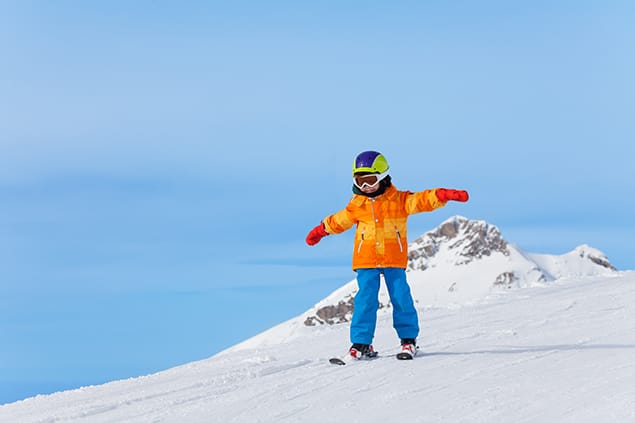What to Expect On Your First Ski Trip
Skiing is one of the most exciting and thrilling sports on earth (not that we’re biased), and a good ski trip should be something every person has on his or her bucket list to be experienced at least once—though, preferably, many, many times.
For the beginning skier, your first ski trip will be spent in learning and practicing, so don’t expect to be able to start swishing down the black runs on this trip. Taking the time to learn basic skills and practice those skills so that they feel natural and ingrained will make you a better skier overall, and all that practice will contribute to your love of the sport in the future. Because your attitude will determine how much fun you have, decide that you’re going to have a great time even as a newbie. After all, you’re going to be playing in the fresh air out on a beautiful mountain! What is better than that?
Do expect to spend your first ski trip mainly learning and practicing.
Don’t worry about looking like a beginner. All beginners look awkward at first.
How to Prepare for a Skiing Trip
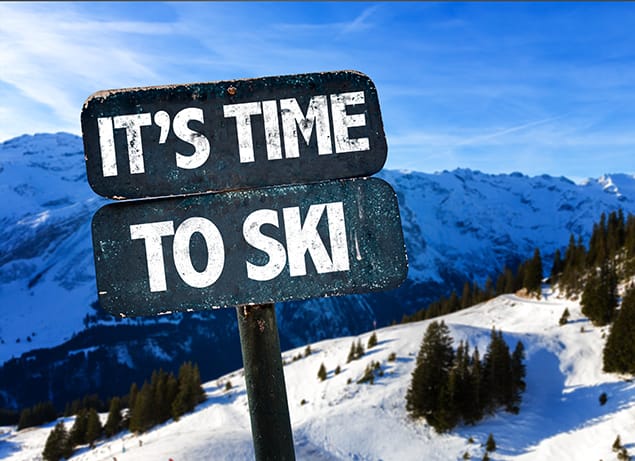
Ski trips take quite a bit of preparation—especially for a beginner. Because the prep is fun and enjoyable, that’s not such a bad thing. The danger is that a beginner won’t take the time to complete all the steps necessary towards making that first ski trip the best it can be and, therefore, will have a mediocre experience at best and a bad experience at worst. Having a mediocre or bad experience might sour you on skiing in the future, and that would be a tragedy.
To make your first ski trip unforgetable, start your preparations at least two months in advance. Late summer and early fall are the perfect times to begin getting your body and equipment ready for the rigors of the slopes before the season starts, but whenever you decide to make your first trip, give yourself adequate time to get yourself into shape.
Fitness & Health
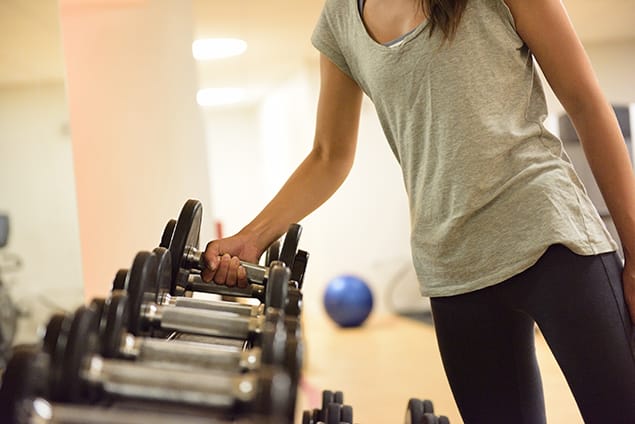
Skiing will force you to use muscles you don’t normally use. You will be twisting and balancing, and your core, arms, and legs will need to be solid and strong. In addition, high altitudes on the slopes mean you’ll be getting less oxygen while you use all those muscles, and cold temperatures quickly suck away your energy. You don’t need to be in perfect shape to hit the slopes, but visiting the gym a few times before your trip is a good idea.
Cardio and weight lifting are great places to start. A physical trainer will help you use correct posture and form to prevent injury, help you push past your natural desire to quit when tired, and to keep you motivated.
You will also need to add additional exercises to work out the muscles you will use in skiing (the core, the foot-and-ankle group, the lower legs, knee flexors and extensors, and the gluteal muscles). Balance boards, in-line skating, ice skating, squash, and racquetball are all good ways to strengthen these muscles because they require you to balance (balance boards, in-line skating, and ice skating) and abruptly change directions (squash and racquetball). Free squats and lunges will strengthen your quadriceps, hamstrings, and glutes.
Kathy Smith from active.com outlines a rigorous six-week exercise plan to get you ready for your first day on the slopes.
In addition, prepping your body means getting proper nutrition. Lay off the junk food and refined flours and sugars and load up on vegetables, fruits, quality protein, and unrefined grains. Who knows? Your ski prep regimen could help you lose a few extra pounds!
Do take action at least two months ahead of time to get your body into better shape.
Don’t be a couch potato until the day you hit the slopes. You could injure yourself, and you will get tired out before lunch on the first day.
Flexibility

You will need to be flexible to handle all the twisting and turning required in skiing. Cold temps on the slopes mean stiff muscles, so if you haven’t prepped your body before your trip, you risk injury to muscles, joints, and ligaments. Flexibility training along with your cardio, weight, and balance training will keep you loose and relaxed, and that will significantly lower your risk of injury.
Yoga is a great way to increase your flexibility. Not only is it mentally relaxing, but you gently and steadily force muscles and ligaments to stretch and lengthen. There are also simple exercises you can do every day to keep yourself flexible. Dr. Craig McLean offers a series of nine very short videos (each less than one minute) detailing these exercises for skiers, which you can add to your regimen.
- Ski Stretching and Flexibility – No. 1 – Hamstring
- Ski Stretching and Flexibility – No. 2 – Hip Rotation
- Ski Stretching and Flexibility – No. 3 – Hip Flexor
- Ski Stretching and Flexibility – No. 4 – Quadriceps
- Ski Stretching and Flexibility – No. 5 – Low Back
- Ski Stretching and Flexibility – No. 6 – Active Low Back
- Ski Stretching and Flexibility – No. 7 – Piriformis
- Ski Stretching and Flexibility – No. 8 – Advanced Piriformis
- Ski Stretching and Flexibility – No. 9 – Calf (gastrocnemius)
Do add flexibility exercises to your ski prep regimen.
Don’t overdue it right away thinking that you will get more flexible more quickly; gently and steadily is the way to go.
Equipment
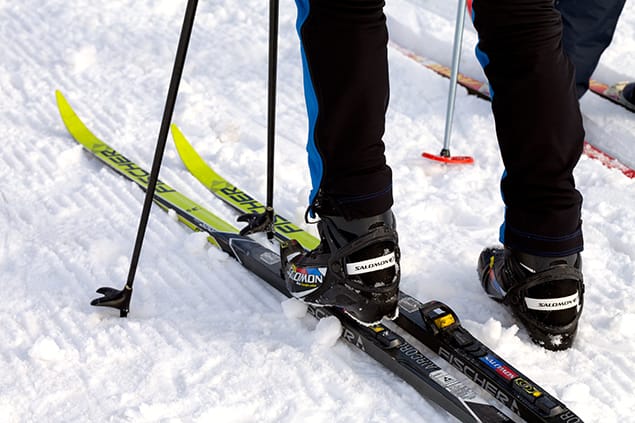
Beginning skiers don’t need to worry about buying equipment for the time being. As you learn and get better at it, your skiing style will change, and if you went out and bought new equipment as a newbie, you’ll just have to spend the money to buy another set. So, for now, rely on rental equipment to get you going.
This is also not a time to salve your vanity by lying about your weight, size, or skiing ability. Be honest so that you can select the equipment and clothing that fits correctly and comfortably and works for you as a beginner.
Picking Your Boots
Ski boots are the most important equipment you’ll choose. Your boots provide stability, support, and control for your skis, so choosing the right boots is of utmost importance. Choose your boots before you select your other equipment, and if you are determined to buy new equipment right now, buy the boots.
There are several things to consider when trying on ski boots:
- First, they must be comfortable—no pressure points or rubbing even when you walk around in them for five to ten minutes.
- Second, they should be tight enough to prevent your heel from lifting when you lean forward against the tongue and put your weight on the balls of your feet.
- Third, make sure the shell of your boot (the outer layer) is right for your level as a beginner. A good pro rental shop will be able to help you make the right selection.
Do insist on boots that are comfortable and fully support your feet and ankles without allowing your heel to rise when you bend your ankles forward.
Don’t settle for the first pair of boots you try on.
Picking Your Skis

No, you don’t need brand new skis as a beginner. Rental skis are just fine at this stage, and you can worry about buying new skis later.
Shorter, wider, flexible skis are better for beginners, but they don’t have to be shiny and pretty. Beginner rental skis are going to be scuffed up, so just make sure the bottoms of your skis are not deeply scratched and that they have a sharp 90-degree edge to give you a good grip and optimal control in the snow. A good rental shop maintains ski bottoms well, but if you notice that they need some work, speak up.
Do accept that beginner rental skis are going to be scratched a bit.
Don’t walk out with skis that have deeply gouged bottoms or edges that are not at 90 degrees.
Picking Your Poles
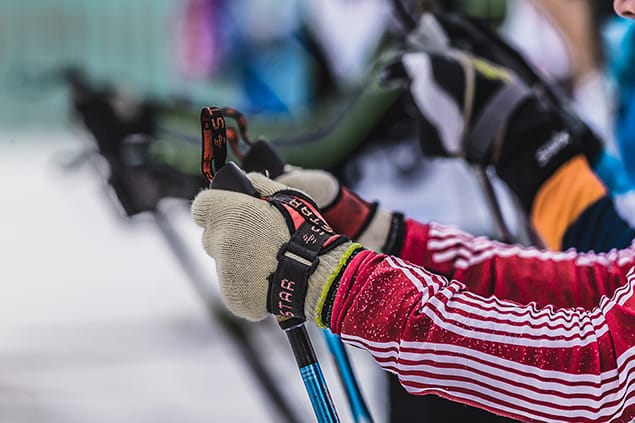
While renting your equipment, be sure that you pick up a pair of downhill ski poles. Again, you don’t need to fuss too much about style at this point, so just concentrate on getting poles that are the right height for you.
While wearing your ski boots (shoes will work, too, if you don’t have ski boots to wear), turn the pole upside down in front of you and rest the grip on the floor. Now grab the pole just under the basket (the circular bit just above the end) and look at the angle your elbow makes. If your elbow is at a 90-degree angle, the poles are the right height. If the angle is smaller than 90 degrees, try a shorter pole. If it’s larger, try a longer pole.
Do get poles that are the right height: your elbow should make a 90-degree angle when you rest the grip on the floor and hold the pole right under the basket.
Don’t worry about style right now.
Accommodations

Part of the fun of a ski trip is the accommodations and the nightlife at a resort or a ski town. Your budget will determine whether or not you can afford a 5-star ski in/ski out room or a bunk in an economy motel. Generally, the closer you are to the resort and the runs, the more you will spend on accommodations. For budget-minded beginners, look a little further afield to find better prices—a room with a short walk to the ski runs or a hotel or motel in a nearby town.
For large groups, renting a condo or vacation home is often more economical than renting a block of rooms. The bonus is that you’ll have a kitchen in which to prepare snacks and meals, which will save the expense of eating in restaurants all the time.
We’ve already collected some great tips on finding well-priced accommodations in our blog post entitled “Smart Tips for Planning a Budget Ski Vacation.”
Do check out the price of accommodations before you arrive. Some places offer discounts for reservations made weeks in advance.
Don’t wait until you get to your destination to start looking for a place to stay. Places in your budget range may be full during peak seasons.
Lift Pass
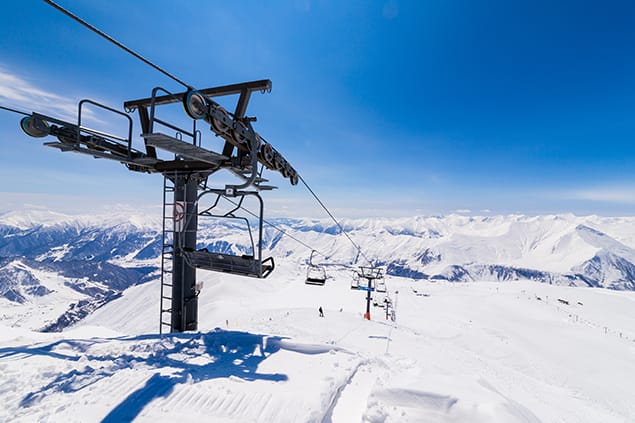
Like airline tickets and hotel room prices, lift ticket prices are all over the place depending on when you buy, where you look, and where you’re going. As you plan your accommodations, make sure to have a look at possible discounts for lift passes just as you do for flights, rental cars, and accommodations. Professional deals sites such as Liftopia.com and Lifttickets.com will yield discounts from 15% to 80% depending on what part of the season you plan to travel in and where. Don’t forget to check your resort’s website, as well, as resorts have begun trying to be competitive with discount sites by offering the best prices for booking in advance.
You can also find good discounts at members’ clubs like Costco or local ski rental shops.
Some ways you can save on lift passes are:
- Book them far in advance
- Look for package deals
- Take advantage of any additional student or senior discount rates
- Buy multi-day tickets rather than single-day tickets
- Schedule your trip to land during the off-season and midweek
Do shop around for lift tickets before your trip.
Don’t buy your lift tickets at the window.
Ski Lessons
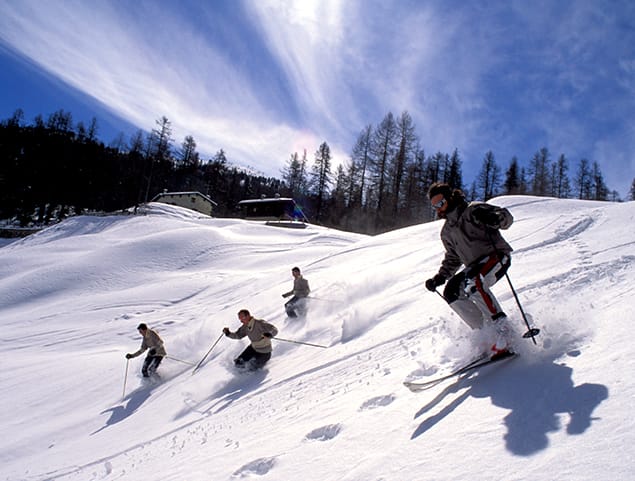
Ski lessons can be expensive, but a good ski instructor can make the difference between a great ski experience and a terrible one. During a ski lesson, you will learn the proper way to use your equipment and how to stop (very important!) while also getting correction on your form and stance as you get comfortable on the slopes. These are all integral to your enjoyment of the sport in the future. Learning how to do things correctly from the start will make it far easier for you to ski well in the future.
Many resorts have dedication beginners’ areas and hills where you can get used to using your skis in the snow without worrying about getting mowed down by speedy showoffs.
At the very least, get some instruction from a friend or relative who is an experienced skier, and do not rely on someone who is also a newbie to teach you. They don’t know what they’re talking about yet and could really mess up your skiing future.
Do participate in ski lessons as much as possible or have an experienced skiing friend help you learn the basics.
Don’t get an inexperienced skier to give you tips.
How to Put Skis On

On flat terrain, lay your skis parallel to each other. Use your poles or a friend for balance, and click your boots into the ski bindings toe first and then the heel.
Do put your skis on when you are on flat terrain.
Don’t start skiing until you know your boots are solidly clicked into the bindings.
Getting Started For the First Time
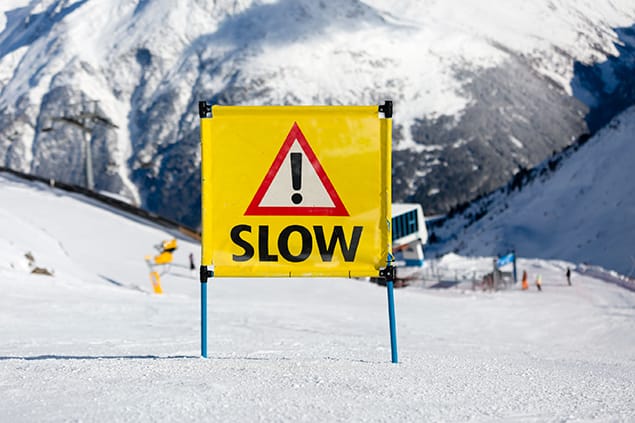
Before you head for a slope, you need to be familiar with the sensation of sliding on the snow and how to control your skis. This is where a good ski instructor comes in extremely handy. Your instructor will lead you through various exercises to get used to where you need to put your weight on your feet, how to step or slide in your skis, how to snowplow, how to stop in an emergency, what to do with your arms and torso, and more.
Do take the time to get familiar with skiing—even if it takes a couple of days of instruction and practice in the beginner area or on the easiest slopes.
Don’t underestimate the power of practicing proper forms and techniques over and over until they become natural to you.
Getting off of the Lift
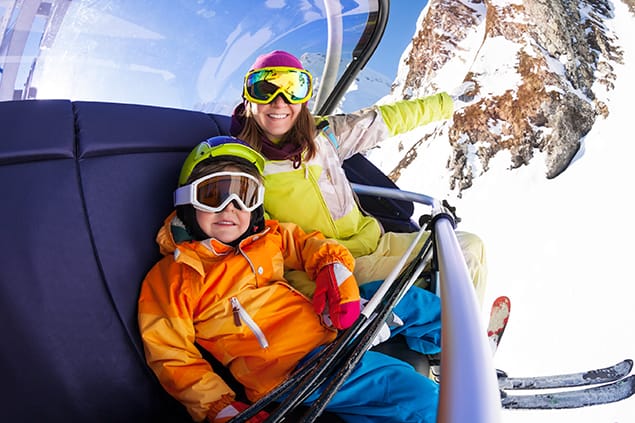
Don’t panic! Getting off the lift will become second nature after the third or fourth time you do it.
- When you get near to the top of the lift (the loading/unloading zone), make sure you have all of your gear in hand and that nothing is accidentally hooking you to the chair.
- Lift the safety bar before you get to the unloading zone.
- Lift the tips of your skis so that they clear the bump at the top of the lift.
- When you are above the level area, stand up and glide out of the unloading zone so that you do not block the chair or the people behind you.
Ski expert Brad Disabella shows you exactly how it’s done in this short video.
Do go through the steps of unloading from a chairlift mentally and stay relaxed while you ride up the slope.
Don’t panic.
Skiing Your First Steps

Obviously, you won’t be walking in your skis—you’ll be gliding. You should not be trying to lift your feet off the ground to get anywhere.
Glide forward by putting your weight on the inner edge of the ski you want to move forward and slide it a step in front of you. Use your ski poles for balance: move your right pole forward when you move your right foot and your left pole forward when you move your left foot. Practice gliding like this in a straight line before going in a circle to the right and then a circle to the left. Finish up by doing a figure eight. You should now be relatively comfortable with “walking” in your skis.
Do keep your feet shoulder-width apart, knees slightly bent, lean gently into the tongues of your boots, and keep your arms extended with your elbows slightly bent.
Don’t put all your weight on your heels or toes.
Maintaining Balance
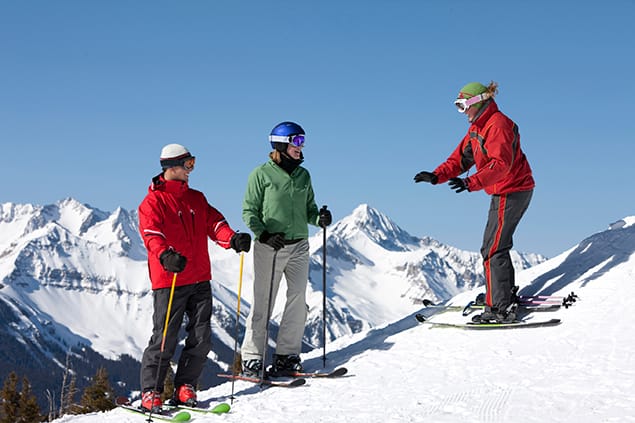
You can only ski if you are balanced correctly. Too far forward and you’ll face plant; too far back and you’ll sit down in the snow. If your balance is off (even if not to those extremes), you inhibit your ability to maneuver quickly and gracefully down a slope.
Your weight should be centered over the area of your foot between the arch and the heel, with gentle pressure from the tongue of your boots felt equally in your shins and your calves. When you are balanced this way, you will be able to maneuver your skis quickly and correctly.
Find your balance with this exercise: stand upright in your boots (no skis) and begin shifting your weight slowly onto your toes until you need your poles to stop you from falling on your face. Now go back to neutral and begin shifting your weight onto your heels until you need your poles to stop you from falling on your behind. Do this a few times to feel the way your weight is distributed correctly when you are upright and properly balanced.
Now put your skis on and repeat the above exercise several times.
Do learn where your balance is and get used to how your weight is distributed.
Don’t skip this step!
Stopping and Turning
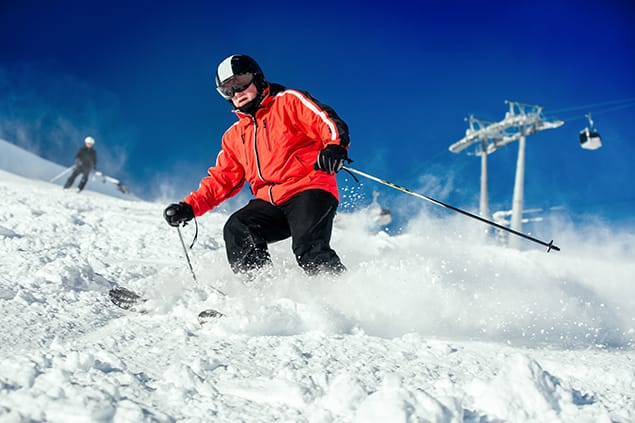
The wedge, or “snowplow” stance is the most important position you learn as a beginner. With the wedge, you can control your momentum. A narrow wedge lets you go faster, and a wider wedge slows you down or allows you to stop.
To form a wedge with your skis, slide the back ends of your skis apart while sliding the front tips near to each other, like a V. Practice sliding your skis into a wedge several times on level ground. Then play with the wedge on a beginner’s slope (or very gentle hill) to see how changing the width of the V changes your forward momentum. The wider the V, the slower you will go. A very wide V will stop you.
To turn, you merely need to put a bit more weight on one leg or the other. Put a little more weight on your right leg and you’ll turn left. Put more weight on your left leg, and you’ll turn right. You can turn in a wedge formation or with your skis close together.
Do spend enough time practicing the snowplow so that you feel like you can control your forward momentum at will—especially being able to stop.
Don’t be afraid to play with the width of the wedge to see how it affects your forward momentum.
Conclusion

While there is nothing like actually getting into a set of skis and trying it out for yourself to really learn how to ski, we hope this quick tutorial will take some of the fear out of it and help you start a lifetime of adventure in this awesome sport.
Here’s what we covered:
- How to prepare for a skiing trip
- Fitness and health
- Flexibility
- Equipment: Boots, Skis, and Poles
- Accommodations
- Lift passes
- Ski lessons
- How to put your skis on
- Getting started for the first time
- Getting off the lift
- Skiing your first steps
- Maintaining balance
- Stopping and turning
We have a few more Do’s and Don’ts for you to ensure that your first trip down the slopes will be as perfect as possible.
Do’s: First Time Skiing
- Do Keep a Positive Attitude
- Do Stay within Your Skill Level
- Do Listen to Experienced Skiers
- Do Respect Other Skiers
- Do Have a Great Time
Don’ts: First Time Skiing
- Don’t Get Too Frustrated
- Don’t be Scared to Push Yourself
- Don’t Ignore your Body
- Don’t Eat and Drink Poorly Beforehand
- Don’t Break the Rules
Resources
The muscle groups used in skiing: http://www.livestrong.com/article/512780-the-5-muscle-groups-used-in-skiing/
6-week exercise plan to prepare for the slopes: http://www.active.com/fitness/articles/get-fit-for-ski-season-6-week-workout-plan-pt-1
Beginning instructions when you’ve got your skis on: http://www.youcanski.com/en/instruction/beginners.htm
http://www.ultimate-ski.com/features/useful-ski-tips/get-ready-for-skiing.aspx
http://www.altitudeholidays.com/blog/entry/the-dos-and-donts-of-skiing-for-beginners
http://theodysseyonline.com/texas-am/dos-donts-skiing-edition/211007
http://www.snowplaza.co.uk/blog/6522-how-to-ski-tips-and-skiing-exercises-for-first-time-skiers/
